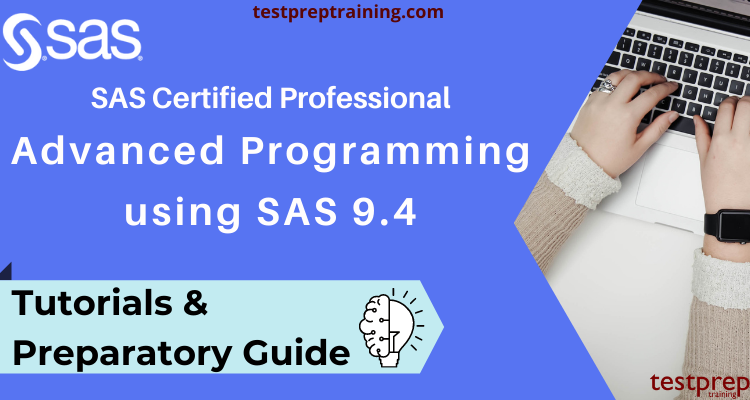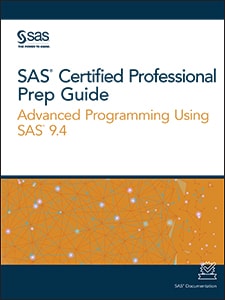SAS® Certified Professional: Advanced Programming Using SAS® 9.4

SAS Certifications are among the most globally accepted credentials in the industry. The SAS Certified Professional – Advanced Programming Using SAS 9.4 credential validates your professional skills and expertise. This exam demonstrates a high level of knowledge in SAS programming expertise in the candidates. Significant topics include SQL processing with SAS, the SAS macro language, advanced SAS programming techniques, and optimizing SAS programs, as well as a unique chapter on building functions with PROC FCMP.
Having access to the right resources becomes quintessential to clear the exam. This Preparatory guide sets you on the right track with its advanced learning resources and detailed steps.

About the Advanced Programming Using SAS 9.4 exam
The SAS Certified Professional: Advanced Programming Using SAS 9.4 exam test the candidate’s knowledge in the areas such as using advanced DATA step programming statements to solve complex problems, writing and interpreting SAS SQL code, creating and using SAS macros, etc. You will also become familiar with the improvements and new functionality that are available in SAS 9.4. Businesses rely on career professionals with secure SAS experience and skills.
Key Learning’s
Successful candidates should have experience in programming using SAS 9.4 and should be able to:

Exam Details
Before venturing into the preparations for the exam, Lets have an idea about the exam details and policies.
This exam covers 10-15 programming projects and 10-15 standard exam questions. The total duration is 150 minutes and you need to achieve a score of 725 to pass the exam.
| Exam Name | SAS Certified Professional: Advanced Programming Using SAS 9.4 |
| Exam Code | A00-232 |
| Exam Duration | 2 hours 5 mins |
| Based On | SAS 9.4 M5 |
| Exam Format | Standard exam questions |
| Number of Questions | 20-30 Questions (10-15 programming projects and 10-15 standard exam questions) |
| Pass Score | 725/ 1000 |
| Exam Fee | $180 USD |
Who should take the exam?
This exam is intended for the following professionals
- Firstly, Data Analyst
- Secondly, Senior Healthcare Economics Analyst
- Further, Senior Healthcare Economics Consultant
- Also, Campus Undergraduate Finance Data Science Intern
- Further, Data Scientist
Exam Prerequisites
Candidates must get the SAS Certified Base Programmer for SAS 9.4 Credential before taking the SAS 9.4 exam.
Types of Questions
SAS Certified Professional – Advanced Programming Using SAS 9.4 is a hybrid exam. There will be practical questions as well as standard test questions that do not require a lab. The exam is designed so that candidates will spend the majority of the time allotted on the practical projects.
Assessment of Programming Questions
The programming projects are assessed with a scoring macro that is stored on the lab computer. At the end of your project, you will invoke the scoring macro. This macro will investigate the results of your project to determine if you completed it correctly. It will look at parameters and content of any output data set as well as values of macro variables stored in the symbol tables. This macro will also investigate the code that you wrote to check that the problem was solved as requested. These are broad checks, so there is still a significant amount of freedom in your chosen coding solution.
SAS® Certified Professional: Advanced Programming Using SAS® 9.4 FAQ
To have further clarity of the Exam Policies and related exam details visit the Advanced Programming Using SAS 9.4 FAQ
Course Outline
Familiarising with the exam course is of great significance to understand the exam concepts. Devote enough time to each topic and have in-depth knowledge of the subject. Moreover, this will also result in strengthening your preparation. This exam covers the following 3 domains:
Accessing Data Using SQL
- Generate detail reports by working with a single table, joining tables, or using set operators in SQL (SAS Documentation: Accessing Data Using SQL)
- Generate summary reports by working with a single table, joining tables, or using set operators in the SQL.
- Construct sub-queries and in-line views within an SQL procedure step. (SAS Documentation: SAS 9.1 SQL Procedure)
- Use special features of the SQL procedure. (SAS Documentation: SQL procedure)
Macro Processing
- Create and use user-defined and automatic macro variables within the SAS Macro Language. (SAS Documentation: SAS 9.1 Macro Language)
- Automate programs by defining and calling macros using the SAS Macro Language.
- Use macro functions. (SAS Documentation: Using macro functions)
- Debug Macros (SAS Documentation: Debugging Techniques)
- Create data-driven programs using SAS Macro Language.
Advanced Techniques
- Process data using 1 and 2 dimensional arrays. (SAS Documentation: Multidimensional Arrays: Creating and Processing)
- Process data using hash objects
- Use SAS utility procedures (SAS Documentation: Utility Procedures)
Preparatory Guide for SAS® Certified Professional: Advanced Programming Using SAS® 9.4 Exam
The roadmap to your success is only complete with the help of right preparatory resources. You need to stay consistent and determined. Moreover you must follow a study pattern while learning from authentic and genuine resources. This step by step Preparatory Guide will be your support throughout your journey towards the exam.

Step 1- Understand Advanced Programming Using SAS 9.4 Exam Objectives
The course domains and modules act as a blueprint for the exam. The syllabus for should be very clear in your mind. Given the vast concepts that this exam covers, course outline plays an important role. Therefore you must familiarise yourself with the Official Guide for the exam before commencing its preparations.
Step 2- Enrol for Trainings by SAS
Trainings provide hands on experience and practical exposure while preparing for the exam. To help you prepare well for the exam SAS offers the following trainings-
Firstly, SAS Programming 3: Advanced Techniques
This course is for SAS programmers who want to learn advanced techniques within the DATA step and procedures. The course builds on the concepts that are presented in the SAS Programming 2: Data Manipulation Techniques course.
Learn how to –
- To begin with, Use additional functions (LAG, FINDC/FINDW, and COUNT/COUNTC/COUNTW).
- Then, Perform pattern matching using PRX functions.
- Further, Process repetitive code, rotate data, and perform table lookups using arrays.
- Moreover, Perform table lookups and sort data using hash and hash iterator objects.
- Subsequently, Create numeric templates using the FORMAT procedure.
- Also, Create custom functions using the FCMP procedure.
SAS Macro Language 1: Essentials
This course focuses on using the SAS macro facility to design, write, and debug macro programs, with an emphasis on understanding how programs that contain macro code are processed.
Learn how to –
- Firstly, Perform text substitution in SAS code.
- Secondly, Use macro variables and macro functions.
- Thirdly, Automate and customize the production of SAS code.
- Also, Conditionally or iteratively construct SAS code.
- Moreover, Write self-modifying, data-driven programs.
SAS SQL 1: Essentials
This course teaches you how to process SAS data using Structured Query Language (SQL).
Learn how to –
- To begin with, Query and subset data.
- Then, Summarize and present data.
- Also, Combine tables using joins and set operators.
- Further, Create and modify tables and views.
- Moreover, Create data-driven macro variables using a query.
- Lastly, Access DBMS data with SAS/ACCESS technology.

Step 3 – Refer Books
Preparations for any exam are incomplete without books. They are the most important ingredient to pass the exam. Choosing the right books and resources becomes important. You can access a detailed explanation of various concepts through authentic books. We suggest you refer the SAS Certified Professional Prep Guide: Advanced Programming Using SAS 9.4.
Step 4 – Join a Community
Staying updated with the current changes is the need of preparations. Therefore, joining a study group or online forum is very necessary. Such online forums provide expert experience and so it is advisable to join them. There are multiple benefits, such as connecting with the candidates who are on the same path as you or clarifying your doubts that may arise during the preparations. You can join the SAS community and stay ahead of your competitors.
Step 5 – Attempt Practice Tests
Finally, it is time to check your preparations. Self-Evaluation is the key and hence your next step is to attempt practice tests. The more you’re going to practice, the better for you. These practice tests provide you with the real exam environment and also help you analyse areas that need improvement. Strengthening your weaker domains will surely help you pass with flying colours. Also, attempting multiple practice tests is vital to boost your confidence So, outperform yourself with each subsequent test to be fully ready on the exam day. Start practising Now!


